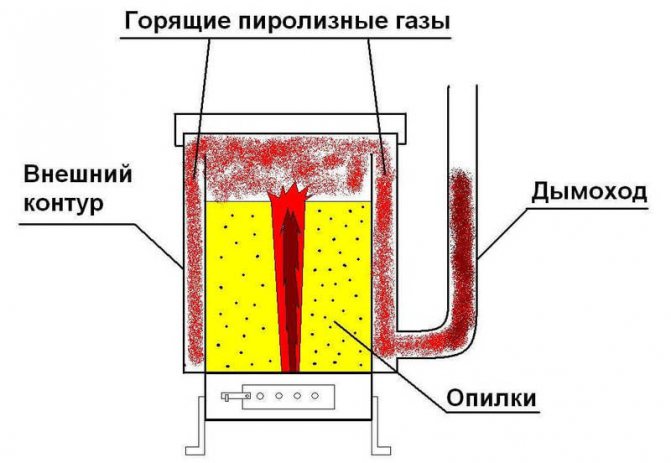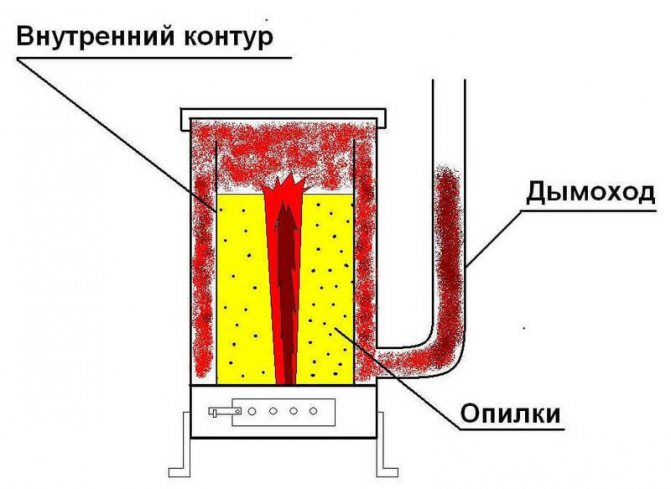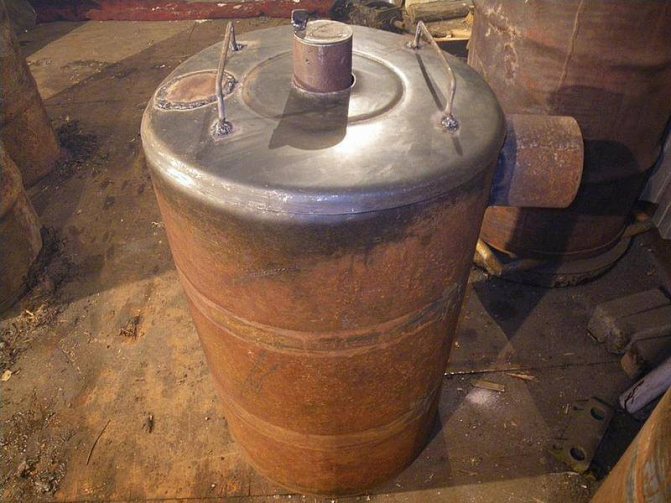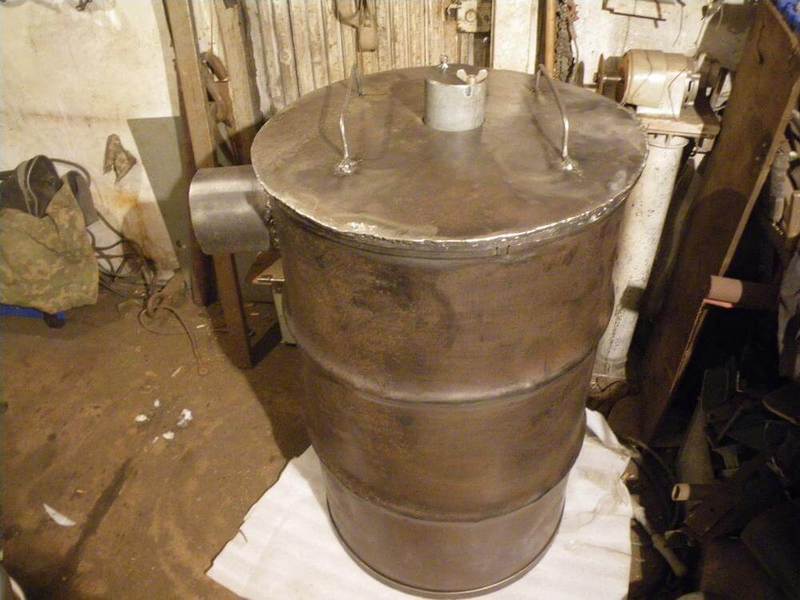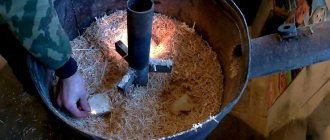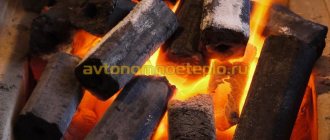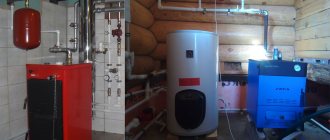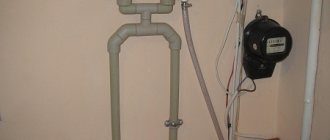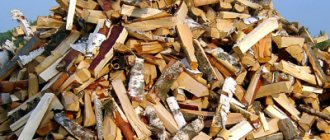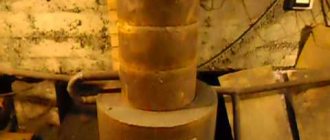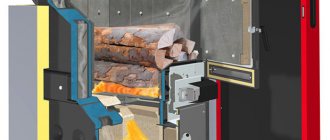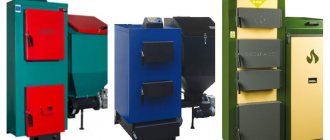Sawdust stoves are not a new phenomenon, but they are still in demand today. Such units only increase their popularity among the population every year due to significant advantages. The design features of devices operating on wood waste contribute to long-term combustion of fuel with maximum heat transfer. Heating with sawdust, a cheap and environmentally friendly material, allows you to significantly save money by purchasing inexpensive raw materials for heating a private house.
Potbelly stoves on sawdust, as they are also called, do an excellent job of heating greenhouses, workshops, service stations, garages and not very large living quarters... The manufacture of such common boilers can be done without any special difficulties with your own hands, having previewed the drawings and studying the assembly process. As a starting material, you can use any improvised containers like old metal barrels, pipes, gas cylinders, of course, without contents, and other similar tanks. Before tinkering with a sawdust stove with your own hands, which you plan to heat in the cold season, we suggest that you familiarize yourself with the design and features of industrial equipment, and draw conclusions on its basis what a wood chip boiler should be, and how to cope with its assembly.
Requirement for sawdust as fuel
As far as we know, sawdust is a very finely chopped wood obtained during the impact of a cutting tool: saws, machine tools. As a rule, sawdust is referred to as woodworking waste from this, the cost of raw materials for fuel is minimal and in some cases even free.
The composition of sawdust is up to 70% carbohydrates (these are cellulose and hemicellulose), 27% lignin. The amount of carbon in sawdust reaches 50%, hydrogen 6% and oxygen 44%, nitrogen content - 0.1%.
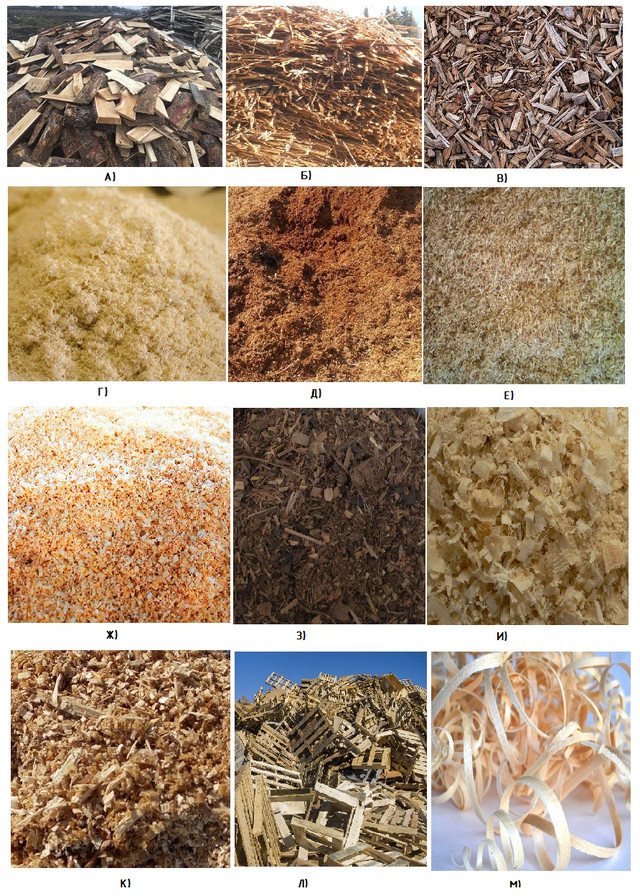
Fig. one Types of wood fuel, wood waste production
A - Obzol board processed into firewood; B - Croaker of conifers; B - Chips of various fractions; D - Sawdust of natural moisture up to 3 mm in size; D - Sawdust of street storage, raw; E - Needle-shaped sawdust of natural moisture; F - Sawdust with moisture W up to 30%; З - Rottened residue of sawdust and wood chips; I - Dry sawdust and shavings; K - Small shavings of street storage; L - Waste wood waste (former furniture, pallets, doors, building structures; M - Long shavings
To use sawdust as fuel, you need to know their technical characteristics. The main parameters that we are interested in are variables and constants. A variable but very important parameter of sawdust is W moisture. With an increase in humidity, the residual calorie content decreases, respectively, with the same volume of sawdust of different humidity, different amounts of heat can be obtained, and the amount of heat can differ significantly. The moisture content of sawdust can not only be controlled but also brought to the desired value. The second important parameter is ash content - the higher the ash content of sawdust, the more impurities in them in the form of sand and bark. The presence of impurities in the fuel somewhat reduces its calorific value, affects the number of cleanings per unit of time. If sawdust is produced, it is obtained as a result of the work of machines on laminated chipboard, chipboard, MDF, etc. that is, from glued wood, then resins and adhesives will necessarily be present in the sawdust, the use of these sawdust is possible only with additional studies on the content of formaldehydes, and especially harmful substances.For the ash residue of harmful substances, disposal must also be provided.
The fraction of sawdust affects their density, the hanging of sawdust in automatic feeding systems. After adjusting the equipment, as was the rule, the sawdust is trying to withstand the same fraction or within certain limits, so as not to adjust the equipment again. So sawdust crushed into dust burns worse with a large flow of blast air than sawdust in structure closer to shavings.
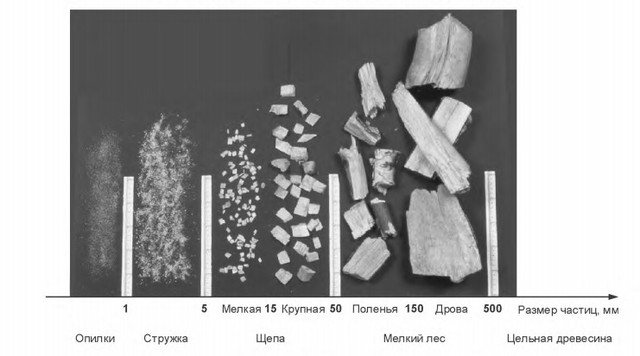

Fig. 1 - B The classification of wood fuel according to GOST 33103.1 - 2014 is shown. GRV company has developed and produces universal boilers operating on all types of wood fuel
When buying sawdust under contracts and agreements, one should adhere to GOST 33103.1 - 2014, which details all the characteristics that should be paid attention to, GOST also regulates methods for determining the moisture content of the fuel and the heat of combustion, which is important since at the time of the conclusion of the agreement on the export of sawdust there may be only moisture and ash content, but in fact, after a while of export, the moisture content of sawdust can increase several times, for example, in the spring period compared to autumn.
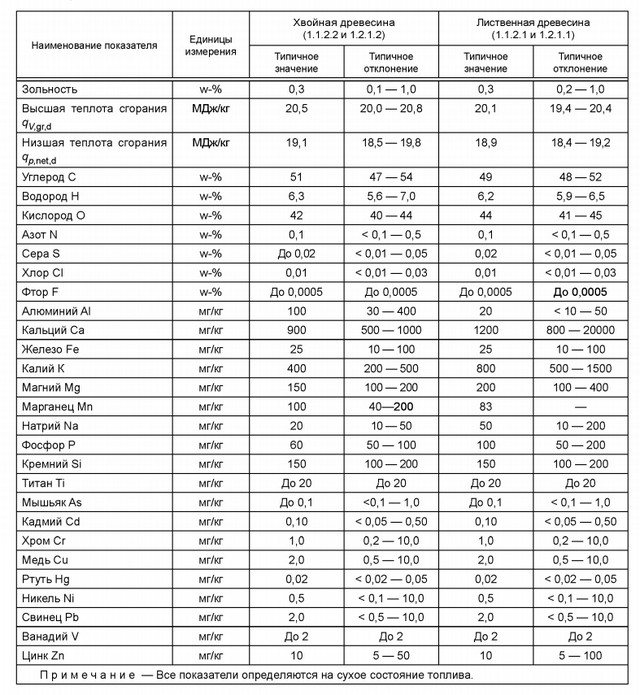

Table No. 1 - General composition and content of substances in wood fuel
Principle of operation
Now let's consider the general arrangement of boilers for chips and sawdust.
The device body consists of the following elements:
- firebox;
- ash pan;
- coil;
- chimney;
- blew;
- heat distributor;
- sensors.
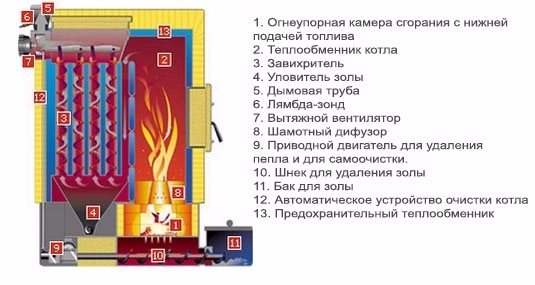

Hargassner boiler device
In the furnace, on a special grate, the process of combustion of chips and sawdust takes place, thanks to which all the ashes and ash remain in the ash pan. This device should be cleaned about 2 times a month.
Due to the fact that chips and sawdust are wood waste and do not form a large flame, the heat exchanger in such boilers is heated by hot gases passing through it.
The heat exchanger consists of tubes that are connected in parallel. It is made of a material that withstands high temperatures well and does not rust, and also has such a quality as a high level of thermal conductivity.
Wood sawdust and wood chips are an especially economical fuel when there is a nearby fuel source: wood processing.
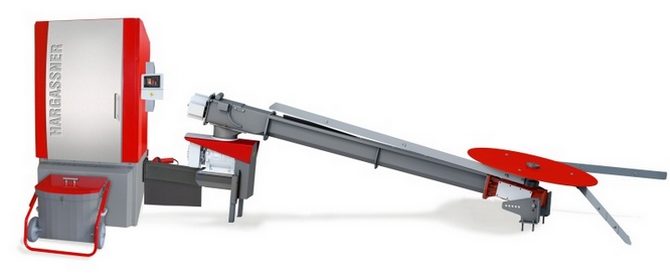

Wood chips boiler Hargassner WTH 150-200
To achieve higher productivity, gas-generating boilers for heating on wood chips and sawdust are used, which are heated not only due to the heat from fuel combustion, but also due to the pyrolysis gas released during the combustion of wood.
In order for the gas to be burned, the boiler furnace consists of two separate chambers. In one, the fuel itself burns, in the other, the gas coming from the first chamber burns.
The device and principle of operation of a long-burning pyrolysis boiler.
Boilers for heating, operating on sawdust and wood chips, like other heating devices, are single-circuit and double-circuit.
The former are designed exclusively for heating the room, the latter are also capable of heating water. Such units are in demand among the owners of private houses, tk. allow not only to provide the house with heat, but also to equip the water supply in the house.
The efficiency of boilers operating on sawdust and wood chips is about 90%.
Sawdust storage
Basis for storage: the higher the humidity, the lower the calorific value of the sawdust.
Sawdust can contain a lot of moisture, sufficient for the process of decay and decomposition. Therefore, the storage of sawdust should not proceed for a long time under atmospheric precipitation. In the process of rotting sawdust, their structure changes (Fig. 1 - H) and the heat of combustion is lost. Before directly burning sawdust must be dried and stored under a canopy (Fig. 2).
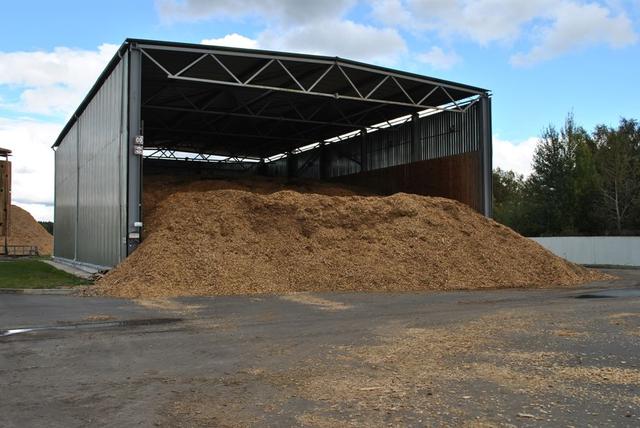

Fig. 2 Sawdust storage under the canopy of a ventilated warehouse
Drying of sawdust is carried out in drying drums, on sites with protection from precipitation, always ventilated. To dry sawdust, wood chips, it should be turned over from the lower layers to the upper ones. Additionally, it is possible to organize a forced supply of air under pressure through the air ducts from the lower layers of sawdust. When storing sawdust, all fire safety rules and regulations should be observed. If sawdust is a secondary raw material after wood processing, then their moisture should be taken into account, and with a low humidity of 20-30%, it is advisable to send the sawdust for combustion to a boiler or heat generator as soon as possible.
Features of pellet boilers
These boilers use pellets as fuel - a versatile biomaterial that is produced in the format of small solid cylindrical granules. It is called universal due to the fact that a wide variety of wastes from woodworking and agricultural production can serve as raw materials for industrial production. Pellets can be made from wood chips, straw, sawdust, peat, sunflower seed waste, etc. The crushed raw materials are pressed, thoroughly dried and turned into high-quality fuel.
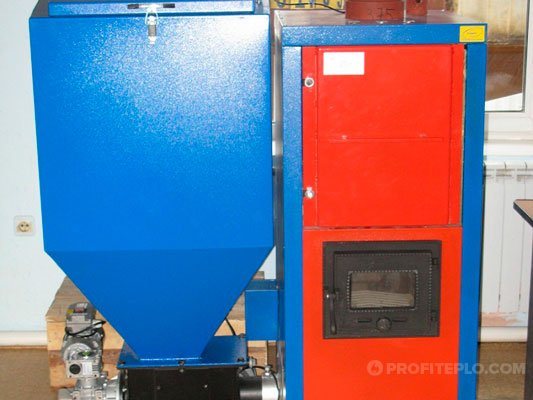

Pellet boiler "Start"
The unit itself is no different in innovation. This is a cast iron (in some models - steel) chamber with a heat exchanger, which is surrounded by a water jacket. The interior of the boiler is filled with various sensors that continuously transmit information about the combustion process to the main controller.
A much more curious device can be considered a screw conveyor for solid fuel boilers, which is responsible for the automatic feeding of pellets into the furnace. The fuel cell is poured onto the auger from the loading device, and its dosage is regulated relative to the current temperature of the coolant. If the fuel in the loading bunker is running out, the user will be notified in advance of this and will be able to quickly fill the bunker with fuel.
Boiler location, boiler room
The first rule of any boiler room is - non-combustible walls, roof. The requirements for the location of the main fuel storage are also added to the sawdust; it should not be located in the same room as the boiler or heat generator. On the equipment, the envisaged bunker is called operational, since its volume is only enough for a few hours of operation, this is primarily due to fire safety requirements. The boiler room must have supply and exhaust ventilation, or the possibility of airing the room. Since the air for the combustion process is taken from inside the boiler room, a supply should be provided.
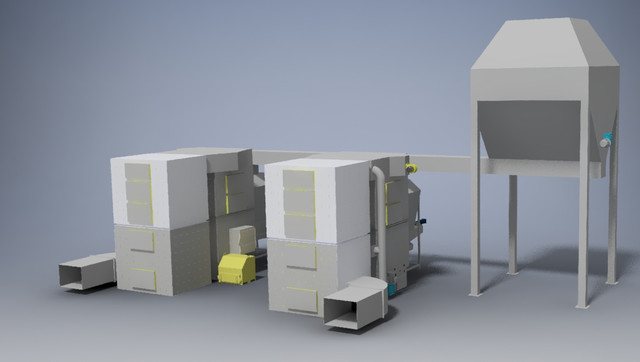

Fig. 3 GRV sawdust boilers and main sawdust storage bin
The dimensions of the boiler room also depend on the method of filling the operational bunker. When using a conveyor or auger, the dimensions of the boiler room are smaller than when special equipment for unloading sawdust arrives at it. It is possible to locate the operational boiler bunker in a separate room in order to reduce the size of the main boiler room.
Closed storage bins are often used in furniture production, which is very convenient and as safe as possible (see Fig. 3).
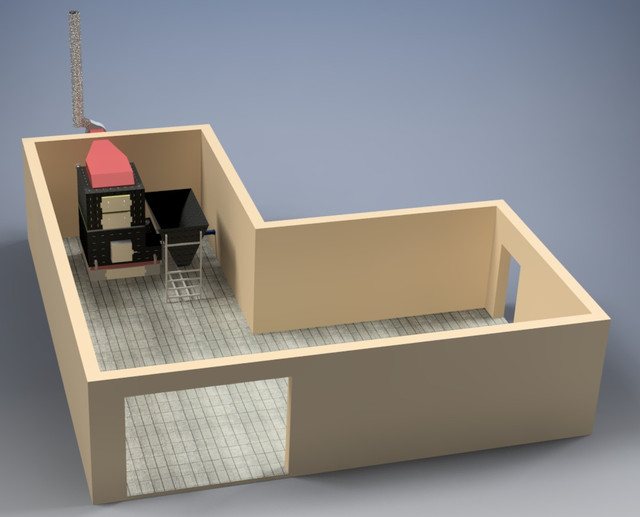

Fig. four Sawdust boiler and low power boiler room GRV
For boilers on sawdust with a capacity of up to 50-400 kW, you can do with one bunker for fuel, while there is no need to organize a transport system from the main fuel storage to the operational bunker.
Device and principle of operation
Elements of the design of the furnace with water heating:
- bunker for pressed wood;
- automatic control system;
- the combustion chamber;
- gas generator;
- heat exchanger;
- blew;
- ash pan;
- heat distributor;
- coil;
- chimney;
- sensors.
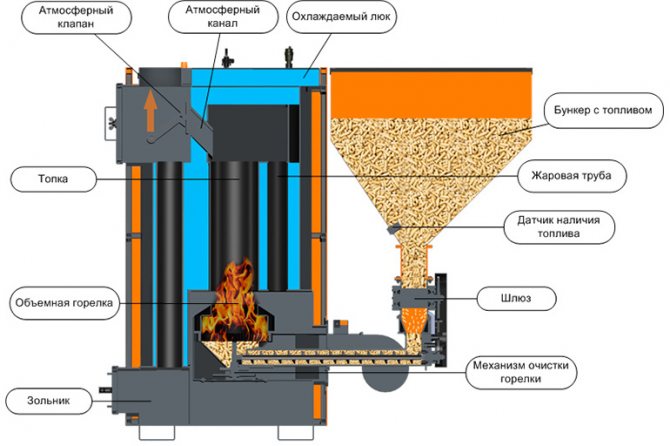

The location depends on the construction project of the country cottage.It is installed inside the house with a partial exit outside the building or completely outside the heated structure.
The process of raw material smoldering is long-lasting and controlled. The combustion products are re-burnt. Air supply is 3-stage.
Fuel flow stages:
- Loading the bunker with wood, where the auger is located. Most often it is installed outside the building.
- With the help of a worm gear, the raw material enters the storage.
- The chips are fed into a container connected to the chamber.
- Further, the fuel is sent to the furnace where it is ignited and burned.
In Europe, the most popular are the Austrian HARGASSNER models. They are installed in country cottages, office centers and hotels.
Fuel supply - sawdust to the boiler hopper
For equipment capacities over 1 MW, the main fuel warehouse with a “moving bottom” system should be used. This warehouse is filled using a front-end loader or dump trucks. From the main warehouse, sawdust is fed by conveyors to the operational hopper of the boiler. It should be noted that fuel in the form of chips (Fig. 1 - M) is practically impossible to supply with standard conveyors and augers, there is a very high degree of hovering of such chips, for this reason, at the initial stage, all characteristics of the fuel, including the geometric shape, should be selected. The following types are excellent for transportation: fig. 1 - B - K.
Boiler working principle
The design of such a heater does not contain an ash pan in the firebox and doors. The boiler is loaded with fuel from above. The container is filled completely from the chimney cut to the very bottom. After that, the combustible mass is pressed tightly with a round flat steel sheet.
A pipe is vertically welded to the round weight. Air masses pass through it into the furnace. The second part of it comes out through the hole in the lid. It is with the help of such a pipe that the heating equipment is ignited.
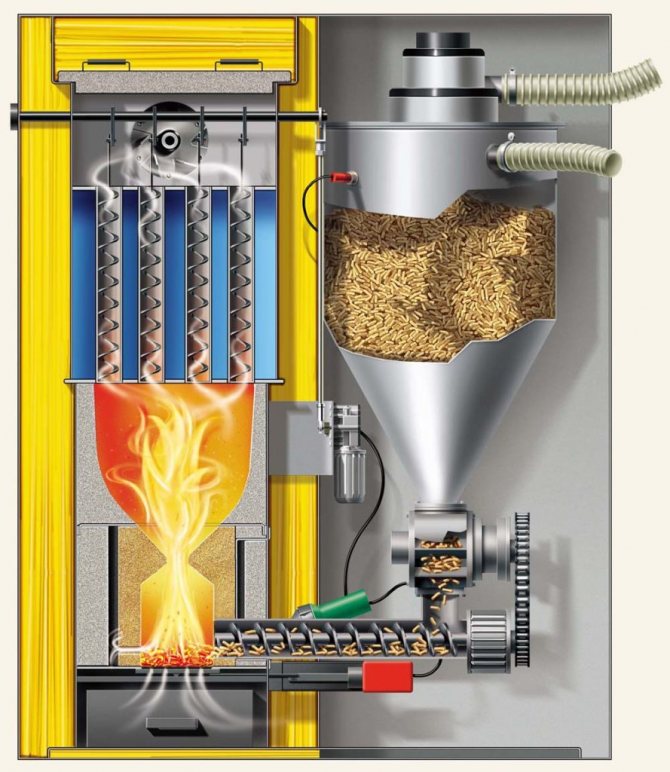

First, the upper layer of fuel begins to burn in the boiler and heat penetrates into the lower part of the structure
The combustion rate is controlled by a damper located at the end of the pipe. As the fuel burns, the heavy load sinks to the bottom. The system has a chimney through which all combustion products escape.
Models of boilers on GRV sawdust
Generally, universal boilers for sawdust, wood, wood chips and coal prevail. Bulk fuels such as sawdust are automatically fed into the swirl burner. The torch from the burner then breaks out into the inside of the furnace, in which the fuel is completely burned out. The walls of the fuel perceive thermal energy and transfer it to the coolant, the combustion products in the form of a mixture of gases are red-hot and move to the boiler heat exchanger, due to the developed area of the heat exchanger, heat transfer from the combustion products to the coolant occurs.
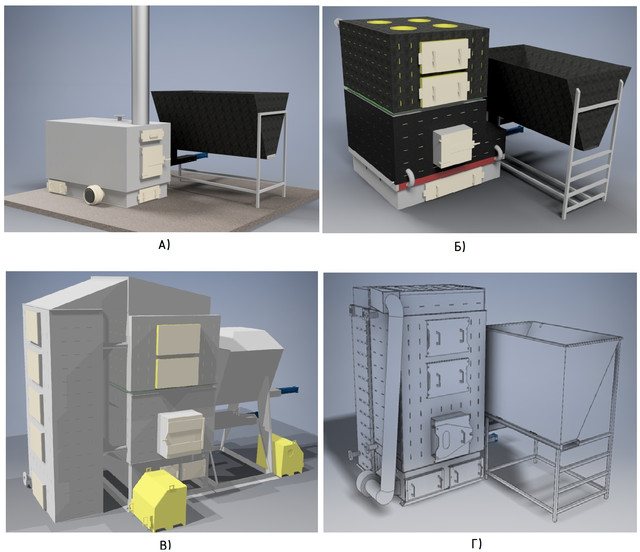

Fig. five GRV sawdust boiler models
A) - Universal boilers up to 300 kW using a vortex burner; B) - A universal boiler on sawdust with a movable grate, without air heating; B) - Universal boilers for sawdust, wood chips, pellets without a movable grate, with automatic ash discharge; D) - Universal boiler for sawdust, wood chips with cleaning the grate, heated blast air
A distinctive feature of universal boilers on sawdust:
Fuel hopper is used with sawdust turner to prevent hanging
All universal boilers GRV have a grate which, like the walls of the furnace, is cooled by a heat carrier
Increased dimensions of the furnace of universal boilers
Spacious ash section of the boiler, the area of the ash section completely covers the area of the furnace
A heat exchanger only with the flow of combustion products outside the tubes, and not vice versa, which significantly increases the intervals between cleaning from carbon deposits, scale
· Universal boilers for sawdust, also operate at full capacity on manual loading, while the dimensions (length and width of the furnace) allow burning wane, pallets, dispose of large branches, etc.
· A separate blowing fan is installed for burning on wood, while the sawdust burner has its own blowing fan. This design is more reliable, you can always switch to reserve fuel without changing the settings and design of the sawdust boiler
The use of steel from 5 to 12 mm ensures a long service life of the equipment
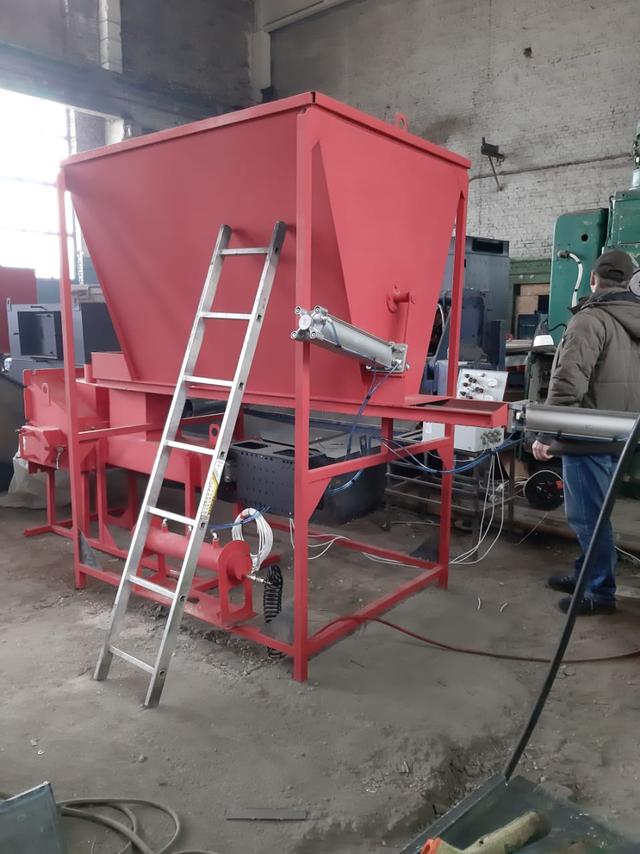

Fig. 6 Sawdust boiler. Boiler hopper with agitator system and movable bottom
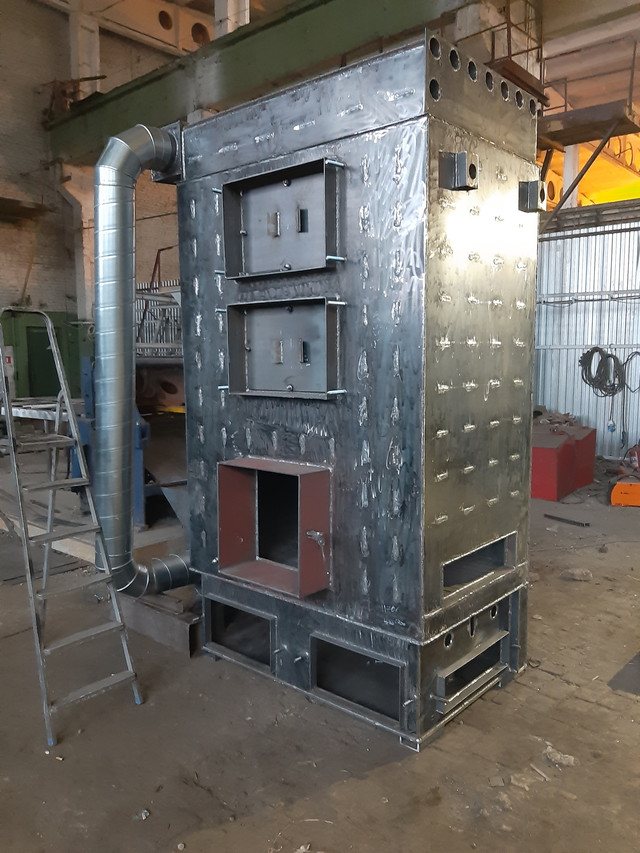

Fig. 7 GRV sawdust boiler during production
In fig. Figures 6 and 7 show GRV technology for sawdust boilers with a blast air heating system for the combustion process. Such systems are used in large CHP plants that use heating to generate electricity. The use of heat from the outgoing combustion products for heating the blast air in this case ensures stable operation of the boiler on sawdust with a humidity of 50-55%, which significantly saves the cost of fuel preparation.
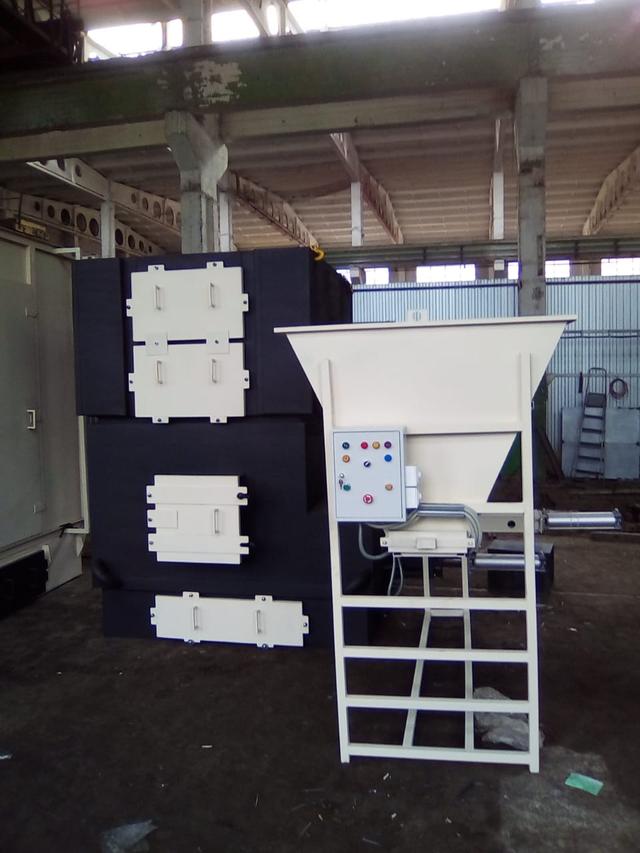

Fig. eight Sawdust boiler without blast air heating system
The use of dry sawdust with a moisture content of W <20% allows the use of boilers of the GRV series (shown in Fig. 8 and Fig. 5 A, B, C) in which there is no preliminary air heating. These boilers have a 7-8% lower aerodynamic resistance and can be installed to operate on natural draft, the requirements for the chimney in this case are up to 10-12 meters, except for boilers with a capacity of over 400 kW.
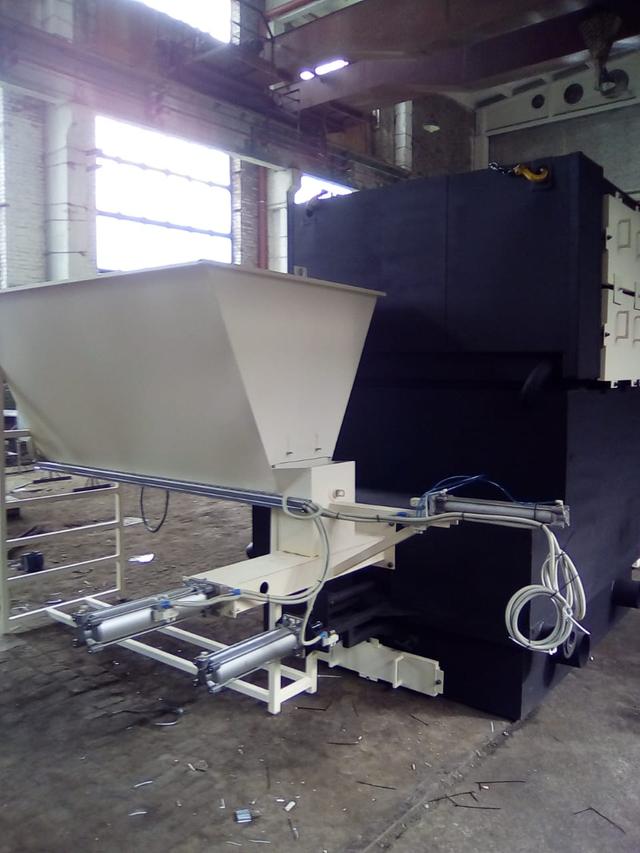

Fig. nine GRV boiler on sawdust, you can consider the fuel supply drive
Homemade construction: materials and assembly order
So, when we figured out the device and the principle of functioning of the industrial design, we can begin to tinker with a household mini-unit similar in action. First you need to stock up on the necessary tools and materials from which the stove will be assembled, namely, we need:
- welding machine;
- pipe of the available diameter (32 - 56 mm);
- gas outlet pipe (100 mm);
- a set of adjustable and gas wrenches;
- Bulgarian;
- roulette;
- clock relay;
- thermal sensor;
- anti-explosion valve;
- water pump;
- ball valves (3 pcs) and screw-thread couplings;
- feeding auger;
- ash removal screw (optional);
- metal corner 45 - 50 mm;
- hydraulic cylinder;
- 200 l barrels for ash pan and sawdust (2 pcs);
- electric fan;
- sheet metal (4 mm);
- tow or fum tape.
The working process
The assembly of homemade sawdust boilers begins with the manufacture of the body and the bottom of the unit. Everyone chooses the dimensions of the structure individually for himself. With the help of a welding machine, a boiler body without a bottom is formed and covered with a water jacket... Homemade boilers can consist of empty gas cylinders, however, we will focus on the welded version, which will allow you to vary the dimensions and power of the installation.
Next, it is necessary to make stiffening ribs between the water jacket, as well as provide technological holes through which air from the fan will be supplied to the combustion chamber. A "live" bottom is mounted from a metal corner, if it is provided, for which it is cut to dimensions of 50x25 mm and the stem is attached to the cylinder for output. When the furnace body on sawdust is ready, it is mounted on a seat, a screw is installed to remove ash and the container is fixed under it.... Now you can mount a fan, an auger that feeds chips, as well as a container for fuel, and we can say that the sawdust burner is assembled with our own hands.
How to light the stove
In order for homemade sawdust stoves to work as efficiently as possible, it is necessary to properly burn fuel. Initially, the crushed wood is placed in a barrel (or in a bunker of the "living" bottom) to 75% of its volume, after which the clock relay is triggered and the auger feeds sawdust into the furnace, where they are kindled with extreme caution with gasoline or diesel fuel. Next, you need to turn on the fan.
There is another scheme for heating with wood chips, which differs slightly from the previous version, since it is suitable for a simpler self-made sawdust boiler (see photo).
For its implementation, it is necessary to fill the fuel chamber with sawdust to three quarters of its volume, while it is recommended to press the crushed wood around the tapered pipe. After ramming, the pipe is removed, the sawdust heating boiler is closed with a lid and a damper on the chimney opens. Firewood is laid and kindled in the lower part of the furnace, from the heat of which the sawdust slowly smolders.
Now you know how to assemble a sawdust oven with your own hands, how it should work and how to heat it correctly. A well-made unit is able to provide economical heating of a small living room or any other outbuilding, and you can learn more about the functioning of a stove-stove from the video below.
Not so long ago, only wood and coal were used as solid fuels. Today, this assortment has been expanded with alternative options, among which pellets, a type of solid fuel made from woodworking waste, occupy a special place. For this, shavings, wood chips, wood dust, bark, cardboard, etc. are used. - waste is processed with plant polymer (lignin), pressed under high pressure and separated into granules. This type of fuel is the most expensive, but at the same time the most rational and can be used in special pellet boilers. In turn, this category of equipment is also highly rated, so some craftsmen implement the pellet burner mechanism on conventional boilers. We will tell and show how a do-it-yourself pellet burner looks like and what it can be made of.
The key difference between a pellet burner and a traditional burner is that the fuel is presented in the form of bulk materials. These are pellets, sawdust, wood chips, some even use agricultural waste. It will not work just to put it into the boiler and set it on fire, since a small volume will not be enough to ignite, and a large one will not ignite. A portioned supply of fuel with simultaneous ignition is required, for which the pellet burner is responsible. It is e that is quite capable of making it yourself.
The difference between piston fuel supply and auger
The use of a piston feed from a pneumatic cylinder ensures fast filling with fuel, safety, since the piston that moves the fuel is also a gate to prevent backfiring. Pneumatics itself is used in many areas of automation, as the most reliable and not whimsical. If foreign objects enter, the controller that controls the boiler does not slowly turn on the warning siren and stops the blast air supply. This system, developed by GRV engineers, has been tested on such fuels as pellet pellets, sawdust of different moisture content, wood chips, wood pulp, and coal.
Working principle of automatic pellet boiler
The pellet boiler with automatic feeding can deliver pellets to the burner in two different ways:
- Auger transmission. Automation fully controls the rate of fuel delivery. The auger itself works almost silently and consumes about 80 W / h. This method of filing is most often used in household models.
- Using a pneumatic conveyor.The pellets are fed into the pellet boiler using air pumped into special pipes under pressure. Such automation is quite noisy and consumes 1.5-2 kW / hour. The undoubted advantage of the system is that the fuel is supplied only once a day, making the boiler practically independent of power outages.
The boiler burner is inextricably linked with the fuel supply system. Automation regulates the pellet feed rate, thus changing the temperature of the coolant. Modern boilers for the home can vary the power in a fairly wide range - from 30% to 100%.
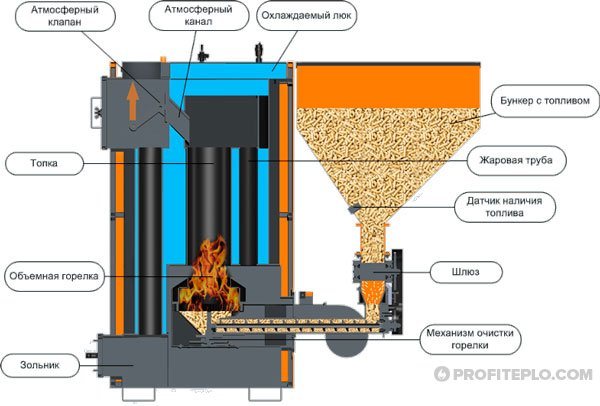

Automatic pellet boiler device
Combustion is carried out with automatic air supply, which helps to avoid undercooling and the formation of excess ash. Ash is collected in a special container. As soon as the coolant heats up to the maximum temperature, the automation gives the command to turn off the boiler. The speed of the feeder slows down to the required minimum and resumes only after cooling down to the temperature specified in the settings.
The boiler is fired up using a plasma method. The ignition system is also fully automated. In the event of an abnormal fire extinction, a special sensor is triggered, and the automation issues a command to reignite.
Firefighting, risks, prevention
Before using sawdust as a fuel, the shavings must be fully aware of the fire hazard, and all measures must be taken initially to comply with fire safety.
Utilization of sawdust and wood pulp in boilers is ten times more environmentally friendly than storing sawdust at landfills, due to the fact that as a result this leads to a fire and sawdust burns with a large chemical underburning more related to the pyrolysis process, while not only the air is poisoned, but soil by pyrolysis products, including acids. In fig. 11 shows an example of sawdust burning in winter under a layer of snow.
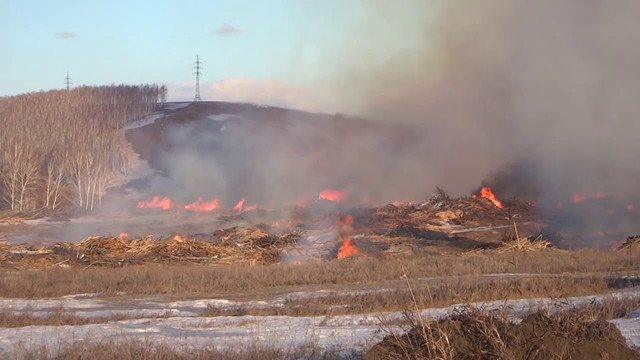

Fig. 10 Fires of slab and sawdust dumps
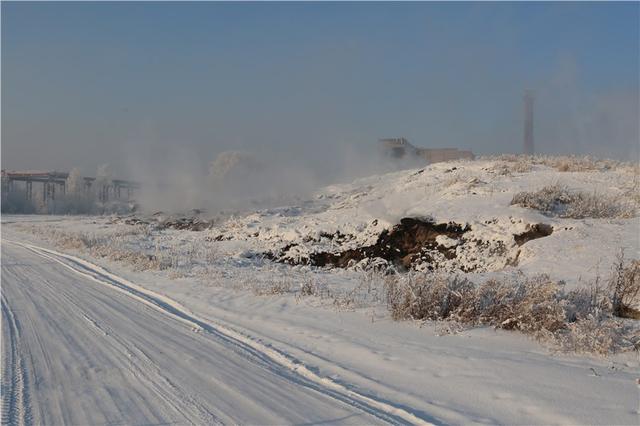

Fig. eleven Smoldering sawdust dumps in winter
Precautions and control measures provided on the boiler, heat generator:
1. Control over the position of the pistons, when the position of the piston deviates from the set one, an alarm is triggered and the sawdust boiler stops its work
2. Control of switching on of the smoke exhauster, when the exhauster is turned off, in order to avoid the possibility of backdraft and smoke in the room, the blowing fans of the GRV boiler and automatic fuel supply are stopped
3. Control of the temperature of the fuel supply tunnel, if the normally set temperature is exceeded, the boiler stops its operation, the tunnel may heat up due to the untimely cleaning of the heat exchanger
4. Closing the fuel hopper with an automatic shutter after fuel supply
5. Mandatory control over the temperature of the coolant, including on GRV heat generators
6. Of course, it is necessary to design a separate fuel storage from the boiler room, only an intermediate bunker is used on the boiler itself and the operational volume of the operational bunker is limited
7. The heat exchanger must be cleaned with the smoke exhauster turned on, and without the combustion process in the boiler.
8. All hatches for cleaning the heat exchanger are equipped with special reflective plates
Device design
All burners are designed to ensure uniform heating of the boiler and the heat carrier by means of an intense flame. The pellet burner is no exception in this series, since it also acts as a part of the heating system. Structurally, this is a medium-sized combustion chamber in the form of a tube, where air is artificially forced up and where the combustion process takes place. In turn, a screw conveyor is responsible for its flow, taking bulk fuel and pouring it into the burner.And the air is supplied by a fan, respectively, the entire mechanism is volatile.
The shape of the combustion chamber does not affect either the combustion rate or the efficiency of the boiler, therefore it can be varied. Circular chambers are most commonly found because they are much easier to manufacture, although rectangular chambers are also quite popular.
In the drawing of the pellet boiler, a rectangular chamber is indicated, while in round ones it is necessary to make a flat base for burning fuel and fix it from the outside to the frontal plane.
As you can see, the operation of the device begins with a standard bunker for pellets and other bulk materials, then the fuel flows through an external auger into the pellet burner itself, where air is blown by a fan and the combustion process takes place.
The design feature is that the supply air, in addition to forcing the flame, simultaneously cleans the burner from the volatile ash formed during combustion. All products are transferred to an ash pan, which is recommended to be cleaned weekly, depending on the intensity of use.
Mechanism of work
The principle of operation consists in the phased supply of bulk material from the hopper through a screw pipe to the combustion chamber, where it ignites and begins to smolder with a minimum amount of air. As the fire ignites, the walls of the chamber heat up, which increases the speed and volume of the air supply. Within a few minutes from the start, the fire evens out and begins to warm up the heat exchanger. Considering that there is no source of natural draft in pellet boilers, this function is performed by the burner when fuel is supplied.
The entire operation of the pellet boiler is controlled by an automatic control unit. The amount of supplied fuel, the volume of air in the chamber, the intensity of combustion, the pressure in the system and the temperature of the heat exchanger depend on it.
The video shows a diagram of a pellet burner - from fuel supply to complete combustion
There are 2 main methods of fuel supply
- Standard - intake of bulk materials from the bunker into the combustion chamber via a screw conveyor. As a rule, this is a free-standing bunker, where a large amount of fuel is poured, sufficient for the constant operation of the boiler for 7-10 times. Such a bunker is cleaned as it gets dirty, but at least once every 2-3 weeks.
- Simplified - funnel-shaped hopper, from where fuel is poured into the auger under its own weight. This is an example of a home-made pellet burner, where the capacity of the hopper is enough for the constant operation of the boiler for a maximum of 3 days.
How to do it yourself
All materials can be found in free sale. Considering that we are talking about a heating device with a direct fire effect, it is necessary to use a heat-resistant stainless steel pipe with a minimum wall thickness of 5-6 mm.
To fix the burner to the boiler body, you need a regular stainless steel 3-4 mm thick.
The supply conveyor can be made from a pipe where you insert the auger, or you can buy a ready-made one at a heating equipment store.
The electric motor is necessary for the operation of the rotary auger, it is better if it is equipment at low speeds.
Install the fan on a special plate (see diagram).
Pellet burner design
Process automation
The peculiarity of the pellet boiler is that there is no device responsible for natural draft in its design. If there is no thrust, then there is no fire, and if an artificial air supply is not provided, the fuel will not even begin to smolder. The fan is responsible for this function. The second power-dependent device that ensures the smooth operation of the boiler is the rotating auger. It is possible to ensure the operation of these devices either with the help of a simple regulator (mechanical process), or by installing an electronic control unit.
The main task when starting a pellet boiler is to achieve a balance between the air flow rate and the volume of fuel. Only in this case the flame will be stable even, and the heat exchanger will be heated.
The electronic control unit is fully responsible for the operation of the boiler. Ideally, you should buy a new one, to which you can connect the auger and fan motors. Perhaps the existing boiler already has electronics, with which it will be possible to make a connection through free contacts. The purpose of this equipment is to control the fan speed and fuel delivery rate.
A filling sensor must be installed on the auger, which monitors the need for fuel supply. When filling the pellet auger, the sensor gives a signal and the fuel supply stops.
The electronic control unit for a solid fuel boiler is not designed to control the operation of the pellet burner and its ignition, since the corresponding control contacts are not provided. This item must be purchased separately.
Video - how to make a pellet burner with your own hands:
Economic efficiency of sawdust boilers
Boilers and heat generators are used to generate heat from fuel combustion, in this case BIO mass in the form of sawdust. Economic efficiency is influenced by transportation costs, the cost of raw materials, and equipment maintenance. You can influence all these factors, but the most basic indicator in this case is the calorific value of the fuel. Sawdust with a moisture content of 30% and a moisture content of 50% will differ twice in calorific value. In order to bring the moisture content of sawdust to 30%, space is needed, warehouses for storage, possibly additional drying plants, it all depends on the scale of processing sawdust into heat.
A promising direction on which the specialists of the GRV company are working is the production of pyrolysis gas from the mass of sawdust in retort installations, gas purification and its use in internal combustion engines. This technology has been known for a long time. We are working on combining gas production and heat production for the needs of production, heating systems. Due to the fact that the installation is located on the street, then in this case it is not required to solve a lot of issues on protection against carbon monoxide.
The use of a pyrolysis plant combined with a heat generator or boiler allows you to place a TPP at your timber processing plant, an agricultural enterprise, as well as at greenhouse complexes, etc.
Features of operation of boilers on sawdust, heat generators on sawdust
The use of sawdust in the form of fuel implies the presence of a minimum infrastructure for the storage of sawdust, the presence of a boiler room and a person responsible for the operation of boiler equipment.
How fuel is supplied
Solid fuel boilers are self-contained. They do not require constant maintenance.
The chips are delivered with several tools. The receiver itself is accessible from the outside of the building. It is equipped with a screw unit that is connected to the storage. When the hopper is fully loaded, the conveyor starts working. He pushes the raw materials into the mechanized compartment.
There are 2 storage options. They differ in the technology of transferring fuel to boilers:
- Blade agitator. The sawdust is delivered by rotating the device.
- The hopper is cone-shaped, rectangular with a screw mechanism.
Not all fuel from the storage enters the furnace immediately. Chips are fed in parts using a special mechanism.
The best manufacturers of automatic pellet boilers
It is generally accepted that the best samples of automatic boilers are made abroad, although over the past few years the quality of domestic products has increased so much that it already allows them to compete on equal terms with the recognized leaders of world production.Customer reviews and sales volumes in Russia allow us to compile a certain rating of automated boilers by producer country, which will help you choose a truly high-quality device:
- Germany. Recognized world market leader. The highest quality of products, automation that works without failures - these are the distinctive features of German boilers. Automatic solid fuel boilers for long burning from Germany are the most expensive on the market today, but they are worth it. The most popular are models under the Heiztechnik and ThermoFLUX brands.
- Japan. Japanese products are traditionally highly automated. Their auto-fired boilers are equipped with a host of additional features that significantly increase ease of use. Among the most famous manufacturers are Kentatsu.
- Turkey. Turkish solid fuel heating systems belong to the middle price segment. In terms of their parameters, boilers from Emtas, Caldera Caltherm or Termodinamik are comparable to domestic counterparts, although they are inferior to them in quality.
- China. Products from this country are traditionally not of high quality and reliability. Only a few models are worthy of attention, which have good functionality and a convenient package. These are solid fuel boilers from the Termal company.
- Serbia. Solid fuel boilers from Serbia are still little known to the Russian consumer. Meanwhile, the Radijator devices deserve the closest attention. They are manufactured in accordance with EU standards and are subject to mandatory quality checks.
- Russia. Over the past 5 years, our country has made a real breakthrough in the production of automatic solid fuel boilers. Coal boilers with automatic fuel supply, pellet models and universal devices are presented in the widest variety. Automation at the highest level, high-quality assembly, attractive appearance, excellent characteristics - all this allows the samples of Obshchemash Peresvet, Obshchemash Valdai, Pereko, Danko to enjoy stable demand.
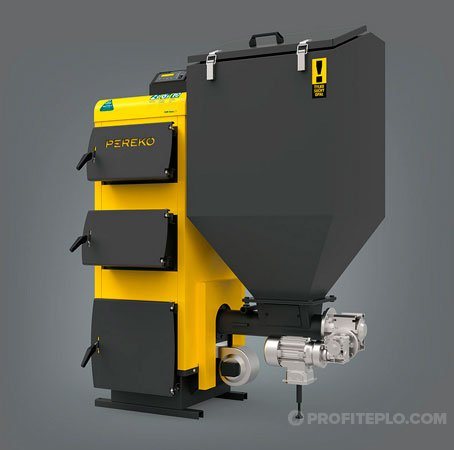

Household solid fuel boiler Pereko

